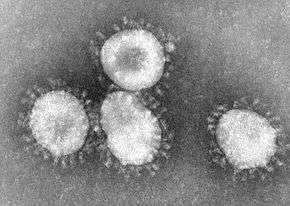Alphacoronavirus
| Alphacoronavirus | |
|---|---|
 | |
| Virus classification | |
| Group: | Group IV ((+)ssRNA) |
| Order: | Nidovirales |
| Family: | Coronaviridae |
| Subfamily: | Coronavirinae |
| Genus: | Alphacoronavirus |
| Type species | |
| Alphacoronavirus 1 | |
Alphacoronaviruses are the first of the four genera, alpha-, beta-, gamma-, and delta-coronavirus in the subfamily Coronavirinae of the family Coronaviridae. Coronaviruses are enveloped, positive-sense, single-stranded RNA viruses that include both human and zoonotic species. Within this subfamily, viruses have spherical virions with club-shaped surface projections and a core shell. The name is from the Latin corona, meaning crown, which describes the appearance of the projections seen under electron microscopy that resemble a solar corona. This genus contains what were previously considered phylogroup 1 coronaviruses.[1]
Both the alpha- and beta-coronavirus lineages descend from the bat gene pool.[2][3][4]
Virology
The virion is enveloped and spherical measuring 120–160 nm in diameter and a core shell of about 65 nm. Glycoproteins and trimers form large surface projections which create the appearance of solar corona from which it takes its name. The genome is positive-sense, single-stranded RNA with a length of 27 to 29 kilobases and a 3’-polyA tail. Two large, overlapping ORFs at the 5'-end of the genome encode the major non-structural proteins expressed as a fusion protein by ribosomal frameshift. These include regions with protease, helicase and RNA polymerase motifs. There are 7 other genes downstream which encode structural proteins. These are expressed from a 3'-coterminal nested set of subgenomic mRNAs.
Classification
- Order Nidovirales
- Family Coronaviridae
- Subfamily Coronavirinae
- Genus Alphacoronavirus; type species: Alphacoronavirus 1
- Species: Alphacoronavirus 1, Feline coronavirus , Canine coronavirus , Human coronavirus 229E, Human coronavirus NL63, Miniopterus bat coronavirus 1, Miniopterus bat coronavirus HKU8, Porcine epidemic diarrhea virus, Rhinolophus bat coronavirus HKU2 and Scotophilus bat coronavirus 512. Transmissible gastroenteritis coronavirus
- Genus Alphacoronavirus; type species: Alphacoronavirus 1
- Subfamily Coronavirinae
- Family Coronaviridae
See also
External links
References
- ↑ "Alphacoronavirus‡—Springer" (PDF). The Springer Index of Viruses: 371–383. doi:10.1007/978-0-387-95919-1_56. Retrieved 2013-06-10.
- ↑ Woo, P. C.; Wang, M.; Lau, S. K.; Xu, H.; Poon, R. W.; Guo, R.; Wong, B. H.; Gao, K.; Tsoi, H. W.; Huang, Y.; Li, K. S.; Lam, C. S.; Chan, K. H.; Zheng, B. J.; Yuen, K. Y. (2007). "Comparative analysis of twelve genomes of three novel group 2c and group 2d coronaviruses reveals unique group and subgroup features". Journal of Virology. 81 (4): 1574–85. doi:10.1128/JVI.02182-06. PMC 1797546
 . PMID 17121802.
. PMID 17121802. - ↑ Lau, S. K.; Woo, P. C.; Yip, C. C.; Fan, R. Y.; Huang, Y.; Wang, M.; Guo, R.; Lam, C. S.; Tsang, A. K.; Lai, K. K.; Chan, K. H.; Che, X. Y.; Zheng, B. J.; Yuen, K. Y. (2012). "Isolation and characterization of a novel Betacoronavirus subgroup A coronavirus, rabbit coronavirus HKU14, from domestic rabbits". Journal of Virology. 86 (10): 5481–96. doi:10.1128/JVI.06927-11. PMC 3347282
 . PMID 22398294.
. PMID 22398294. - ↑ Lau, S. K.; Poon, R. W.; Wong, B. H.; Wang, M.; Huang, Y.; Xu, H.; Guo, R.; Li, K. S.; Gao, K.; Chan, K. H.; Zheng, B. J.; Woo, P. C.; Yuen, K. Y. (2010). "Coexistence of different genotypes in the same bat and serological characterization of Rousettus bat coronavirus HKU9 belonging to a novel Betacoronavirus subgroup". Journal of Virology. 84 (21): 11385–94. doi:10.1128/JVI.01121-10. PMC 2953156
 . PMID 20702646.
. PMID 20702646.